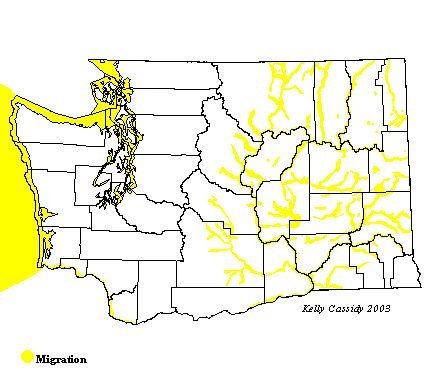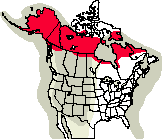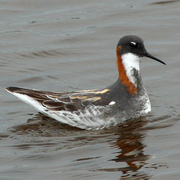Red-necked Phalarope
General Description
The Red-necked Phalarope (formerly the Northern Phalarope) is the smallest of the three phalaropes and has the shortest bill. It has black legs and lobed toes. The adult female in breeding plumage is dark with a gray breast and dark gray back with brown stripes. Her head and cheeks are dark, and her neck is deep rufous, with a white throat patch and small white spot above the eye. The male looks similar but is not as brightly colored and has more white over his eye, making an eye-line rather than a spot. The non-breeding adult Red-necked Phalarope and Red Phalarope appear similar. Both are gray above and white below, with a white head and face and dark ear-patch. However, the Red-necked Phalarope's back is streaked gray, and the Red Phalarope's back is unstreaked. The juvenile Red-necked Phalarope is buff and black streaked, but it has molted out of that plumage by the time it moves through Washington. In flight, all plumages show a white stripe down the middle of their wings. The Red-necked Phalarope has a dark center stripe down its tail, with lighter sides. From below, it appears mostly white, but with more dark edging on its wings than the Red Phalarope.
Habitat
Red-necked Phalaropes spend up to nine months at a time at sea. They nest in the low Arctic, on tundra ponds with marshy shores and bogs. They usually breed farther inland and at higher elevations than do Red Phalaropes, which prefer coastal breeding areas. During migration, large numbers gather at hyper-saline lakes before heading south. Many migrate over the open ocean, often within sight of land. Some migrate over land and can be seen on reservoirs, lakes, and coastal marshes. At sea, they gather at upwellings and convergence zones where food is brought to the surface. They are sometimes blown onshore by storms and during these times can be found anywhere, especially at sewage ponds.
Behavior
Outside of the breeding season, Red-necked Phalaropes are highly social and are often found in flocks. These active birds pick small bits of food from the water's surface. When swimming in shallow water, they will spin in tight circles and create upwellings of food.
Diet
During the breeding season and when on fresh water, they eat mostly insects. At saline lakes, they consume brine shrimp in large numbers. When at sea, they eat zooplankton and other small creatures that rise to the surface at convergence zones.
Nesting
Females arrive on the breeding grounds before males. They establish territories and display to attract mates. Both sexes start scrapes on mounds or tussocks near the water, and the female picks one. The male adds a lining of grass, sedge, lichen, and leaves in a shallow depression concealed in sedge, ferns, grass, or shrubs. After laying four eggs, the female leaves the male to incubate the eggs and provide all parental care. The female often tries to attract another mate. The male incubates the eggs for 17 to 21 days and tends the brood once they hatch. The young leave the nest within a day of hatching and find their own food. The male leaves the young after about two weeks. The young start to fly at 16 to 17 days, and can fly well by 20 to 22 days.
Migration Status
These migrants travel long distances from their Arctic breeding grounds to winter in tropical seas around the globe. They migrate over land and over the ocean, and gather in the fall at saline lakes in the North American west before heading to their wintering grounds.
Conservation Status
The Canadian Wildlife Service estimates the global population of Red-necked Phalaropes at 4,000,000 birds, with 2,500,000 in North America. The remainder breed throughout the far Northern Hemisphere. While the population is difficult to monitor, there has been some evidence of declines in some areas, and Red-necked Phalaropes have disappeared from some traditional staging areas in recent years. Very little is known about the status of their wintering areas or what effect El Niņo events have on the population. More study is necessary to understand the status of the population and its conservation needs.
When and Where to Find in Washington
Red-necked Phalaropes are common offshore migrants which at times can also be seen from the coast. Northbound Red-necked Phalaropes are most easily seen during offshore boat trips, especially where two ocean currents converge. Offshore and along the coast, Red-necked Phalaropes begin to arrive in April and become more common during May, but moving through quickly, they are seen only rarely in June. Offshore and along the coast, returning migrants can be found in good numbers from early July through mid-Sepember or October in some years. Numbers then taper off until the end of the migration in late November.
In the inland Spring migration, Red-necked Phalaropes begin to appear in small numbers in mid-April, inrease to "uncommon" status in May, and are again seen only rarely in early June. After a gap of several weeks, southbound migrants appear, increasing from early July, peaking in August through early September, and decreasing again through late September and October.
 Abundance
Abundance
| Ecoregion | Jan | Feb | Mar | Apr | May | Jun | Jul | Aug | Sep | Oct | Nov | Dec |
|---|---|---|---|---|---|---|---|---|---|---|---|---|
| Oceanic | U | C | R | C | U | U | U | |||||
| Pacific Northwest Coast | U | F | R | U | F | F | ||||||
| Puget Trough | R | F | R | C | F | R | ||||||
| North Cascades | ||||||||||||
| West Cascades | U | R | U | |||||||||
| East Cascades | ||||||||||||
| Okanogan | ||||||||||||
| Canadian Rockies | ||||||||||||
| Blue Mountains | ||||||||||||
| Columbia Plateau | U | U | F | F |
Washington Range Map

North American Range Map


Family Members
 Spotted SandpiperActitis macularius
Spotted SandpiperActitis macularius Solitary SandpiperTringa solitaria
Solitary SandpiperTringa solitaria Gray-tailed TattlerTringa brevipes
Gray-tailed TattlerTringa brevipes Wandering TattlerTringa incana
Wandering TattlerTringa incana Greater YellowlegsTringa melanoleuca
Greater YellowlegsTringa melanoleuca WilletTringa semipalmata
WilletTringa semipalmata Lesser YellowlegsTringa flavipes
Lesser YellowlegsTringa flavipes Upland SandpiperBartramia longicauda
Upland SandpiperBartramia longicauda Little CurlewNumenius minutus
Little CurlewNumenius minutus WhimbrelNumenius phaeopus
WhimbrelNumenius phaeopus Bristle-thighed CurlewNumenius tahitiensis
Bristle-thighed CurlewNumenius tahitiensis Long-billed CurlewNumenius americanus
Long-billed CurlewNumenius americanus Hudsonian GodwitLimosa haemastica
Hudsonian GodwitLimosa haemastica Bar-tailed GodwitLimosa lapponica
Bar-tailed GodwitLimosa lapponica Marbled GodwitLimosa fedoa
Marbled GodwitLimosa fedoa Ruddy TurnstoneArenaria interpres
Ruddy TurnstoneArenaria interpres Black TurnstoneArenaria melanocephala
Black TurnstoneArenaria melanocephala SurfbirdAphriza virgata
SurfbirdAphriza virgata Great KnotCalidris tenuirostris
Great KnotCalidris tenuirostris Red KnotCalidris canutus
Red KnotCalidris canutus SanderlingCalidris alba
SanderlingCalidris alba Semipalmated SandpiperCalidris pusilla
Semipalmated SandpiperCalidris pusilla Western SandpiperCalidris mauri
Western SandpiperCalidris mauri Red-necked StintCalidris ruficollis
Red-necked StintCalidris ruficollis Little StintCalidris minuta
Little StintCalidris minuta Temminck's StintCalidris temminckii
Temminck's StintCalidris temminckii Least SandpiperCalidris minutilla
Least SandpiperCalidris minutilla White-rumped SandpiperCalidris fuscicollis
White-rumped SandpiperCalidris fuscicollis Baird's SandpiperCalidris bairdii
Baird's SandpiperCalidris bairdii Pectoral SandpiperCalidris melanotos
Pectoral SandpiperCalidris melanotos Sharp-tailed SandpiperCalidris acuminata
Sharp-tailed SandpiperCalidris acuminata Rock SandpiperCalidris ptilocnemis
Rock SandpiperCalidris ptilocnemis DunlinCalidris alpina
DunlinCalidris alpina Curlew SandpiperCalidris ferruginea
Curlew SandpiperCalidris ferruginea Stilt SandpiperCalidris himantopus
Stilt SandpiperCalidris himantopus Buff-breasted SandpiperTryngites subruficollis
Buff-breasted SandpiperTryngites subruficollis RuffPhilomachus pugnax
RuffPhilomachus pugnax Short-billed DowitcherLimnodromus griseus
Short-billed DowitcherLimnodromus griseus Long-billed DowitcherLimnodromus scolopaceus
Long-billed DowitcherLimnodromus scolopaceus Jack SnipeLymnocryptes minimus
Jack SnipeLymnocryptes minimus Wilson's SnipeGallinago delicata
Wilson's SnipeGallinago delicata Wilson's PhalaropePhalaropus tricolor
Wilson's PhalaropePhalaropus tricolor Red-necked PhalaropePhalaropus lobatus
Red-necked PhalaropePhalaropus lobatus Red PhalaropePhalaropus fulicarius
Red PhalaropePhalaropus fulicarius

